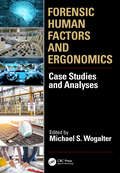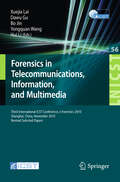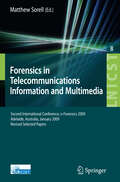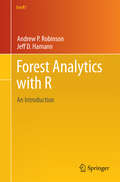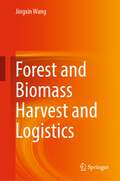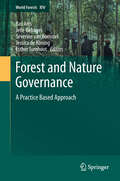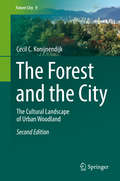- Table View
- List View
Forensic Human Factors and Ergonomics: Case Studies and Analyses (Human Factors and Ergonomics)
by Michael S. WogalterThis book has 18 case study chapters investigating various injury scenarios through the use of a Human Factors and Ergonomics (HFE) analysis. Each injury scenario derives from one or more similar lawsuits (but names, places and some of the details are fictionalized). The scenarios describe a ‘slice of life’ of people interacting with products, equipment, tasks, and environments before they are seriously hurt. The forensic analysis that follows each scenario gives a background of prior similar events and systematically examines potential causes leading to the injury event. There is emphasis on the person-machine interface, human error, hazard analysis, hazard control and a model of communication-human information processing (C-HIP). Chapters are authored by highly experienced expert witnesses in HFE. The methods used are general techniques that can be applied to other injury scenarios, but would be better if employed earlier in a product’s life cycle to prevent or limit injury. The first three chapters introduce concepts useful for the analyses in the case study chapters. The last chapter offers some broad take-away points that cut across several of the case studies. Features contributions by persons who have extensive experience in HFE and who have served professionally in the role of an expert witness in various legal cases mostly in product liability Gives a broad range of situations to illustrate where HFE considerations could improve product or environmental safety. There is an emphasis on children/caregivers, and adult activities such as driving Uses mitigation strategies to reduce the likelihood of occurrence and severity of adverse events Includes a first-person scenario at the beginning of each chapter Allows the lessons learned to be adaptable to other domains where people interact with products and environments
Forensic Interpretation of Glass Evidence
by James Michael Curran John S. Buckleton Tacha Natalie Hicks ChampodIntended for forensic scientists and students of the discipline, Forensic Interpretation of Glass Evidence provides the practicing forensic scientist with the necessary statistical tools and methodology to introduce forensic glass evidence into the laboratory. With free software available for downloading at the author's Web site, scientists can app
Forensic Issues in Alcohol Testing
by Steven B. Karch FfflmExtracted from the Drug Abuse Handbook, 2nd edition, to give you just the information you need at an affordable price. Forensic Issues in Alcohol Testing offers concise and focused information specific to the interests of forensic scientists and clinical and forensic toxicologists. It analyzes the acute effects of alcoho
Forensic Materials Engineering: Case Studies
by Peter Rhys Lewis Ken Reynolds Colin Gagg Colin GaggMost books on forensic engineering focus on civil engineering failures rather than consumer or general mechanical products. Unique both in scope and style, this treatment is built upon case studies of real accidents, broadly focused on consumer products, and dedicated to problem solving through scientific principles. Each well-illustrated case stud
Forensic Materials Engineering: Case Studies
by Peter Rhys Lewis Ken Reynolds Colin Gagg Colin GaggMost books on forensic engineering focus on civil engineering failures rather than consumer or general mechanical products. Unique both in scope and style, this treatment is built upon case studies of real accidents, broadly focused on consumer products, and dedicated to problem solving through scientific principles. Each well-illustrated case stud
Forensic Metrology: An Introduction to the Fundamentals of Metrology for Judges, Lawyers and Forensic Scientists (Research for Development)
by Alessandro Ferrero Veronica ScottiThis book offers up-to-date information and guidance on the application of metrology in legal proceedings, clarifying the limits of validity of scientific evidence and presenting an illuminating series of case studies in which measurement uncertainty has played an important role. The fundamental concepts of metrology are discussed, and it is explained how metrology is capable of quantifying the reliability of measurement results and thereby contributing to appropriate decision making. With the aid of the presented case studies, this book will assist readers in understanding how legal decisions should be made in the presence of uncertainty. Areas covered in those studies include breath alcohol concentration analysis, and DNA profiling. Nowadays, decisions in most legal cases are based on evidence obtained through scientific analysis involving the acquisition of accurate measurements. Against this background, Forensic Metrology will be of value for lawyers and judges in both civil and common law countries, as well as engineers and other scientists with an interest in the subject.
Forensic Radio Survey Techniques for Cell Site Analysis
by Joseph HoyThis book is intended to be used as both a text book and as an aide memoire handbook by forensic radio survey engineers, particularly those working for official police agencies. The book provides a simple but detailed overview of the operation of cellular networks (GSM, UMTS and LTE, US CDMAOne/CDMA2000, amongst others). In addition, the author also provides an overview of the technical theories that underpin cellular radio systems – basic radio theory and a simple explanation of the mathematical concepts that underlie measurements scales such as dB and dBm. The main part of the book, however, focuses on radio surveys, the various types of survey, the techniques employed for each survey and the considerations and potential problems that can be encountered when surveying different types of network. The final section deals with processing and interpreting the results of radio surveys and examines the information that can be gained from them.
Forensic Radio Survey Techniques for Cell Site Analysis
by Joseph HoyThis book is intended to be used as both a text book and as an aide memoire handbook by forensic radio survey engineers, particularly those working for official police agencies. The book provides a simple but detailed overview of the operation of cellular networks (GSM, UMTS and LTE, US CDMAOne/CDMA2000, amongst others). In addition, the author also provides an overview of the technical theories that underpin cellular radio systems – basic radio theory and a simple explanation of the mathematical concepts that underlie measurements scales such as dB and dBm. The main part of the book, however, focuses on radio surveys, the various types of survey, the techniques employed for each survey and the considerations and potential problems that can be encountered when surveying different types of network. The final section deals with processing and interpreting the results of radio surveys and examines the information that can be gained from them.
Forensic Radio Survey Techniques for Cell Site Analysis
by Joseph HoyFORENSIC RADIO SURVEY TECHNIQUES FOR CELL SITE ANALYSIS Overview of the end-to-end process of planning, undertaking, and reporting of forensic radio surveying to support cell site analysis The newly updated and revised Second Edition of Forensic Radio Survey Techniques for Cell Site Analysis provides an overview of the end-to-end process of planning, undertaking, and reporting of forensic radio surveying to support the forensic discipline of cell site analysis. It starts by recapping and explaining, in an accessible way, the theory, structure, and operation of cellular communications networks, then moves on to describe the techniques and devices employed to undertake forensic radio surveys. Worked examples are used throughout to demonstrate the practical steps required to plan and undertake forensic radio surveys, including the methods used to analyze radio survey data and compile it into a court report. A summary section condenses the technical and practical elements of the book into a handy reference resource for busy practitioners. The Second Edition contains 25% brand new material covering 5G New Radio networks and ‘6G and beyond,’ critical communications, mobile satellite communications, IoT networks, Cell Site Analysis Tools, and much more. Other sample topics covered in Forensic Radio Survey Techniques for Cell Site Analysis include: Radio theory, covering RF propagation, basic terminology, propagation modes, multipath transmission, and carrying information on a radio signal Core networks, including 2G, 3G, 4G, and 5G, subscriber and device identifiers, and international and temporary mobile subscriber identities Cell access control, covering cell barring, forbidden LAC/TAC, location updating, inter- and intra-carrier handovers, and 3GPP network types Forensic radio surveys objectives, terminology, and types, along with location, static spot, and indoor surveys The Second Edition of Forensic Radio Survey Techniques for Cell Site Analysis is an essential reference on the subject for police analysts, practitioners, technicians, investigators, and cell site experts, along with legal professionals and students/trainees in digital forensics.
Forensic Radio Survey Techniques for Cell Site Analysis
by Joseph HoyFORENSIC RADIO SURVEY TECHNIQUES FOR CELL SITE ANALYSIS Overview of the end-to-end process of planning, undertaking, and reporting of forensic radio surveying to support cell site analysis The newly updated and revised Second Edition of Forensic Radio Survey Techniques for Cell Site Analysis provides an overview of the end-to-end process of planning, undertaking, and reporting of forensic radio surveying to support the forensic discipline of cell site analysis. It starts by recapping and explaining, in an accessible way, the theory, structure, and operation of cellular communications networks, then moves on to describe the techniques and devices employed to undertake forensic radio surveys. Worked examples are used throughout to demonstrate the practical steps required to plan and undertake forensic radio surveys, including the methods used to analyze radio survey data and compile it into a court report. A summary section condenses the technical and practical elements of the book into a handy reference resource for busy practitioners. The Second Edition contains 25% brand new material covering 5G New Radio networks and ‘6G and beyond,’ critical communications, mobile satellite communications, IoT networks, Cell Site Analysis Tools, and much more. Other sample topics covered in Forensic Radio Survey Techniques for Cell Site Analysis include: Radio theory, covering RF propagation, basic terminology, propagation modes, multipath transmission, and carrying information on a radio signal Core networks, including 2G, 3G, 4G, and 5G, subscriber and device identifiers, and international and temporary mobile subscriber identities Cell access control, covering cell barring, forbidden LAC/TAC, location updating, inter- and intra-carrier handovers, and 3GPP network types Forensic radio surveys objectives, terminology, and types, along with location, static spot, and indoor surveys The Second Edition of Forensic Radio Survey Techniques for Cell Site Analysis is an essential reference on the subject for police analysts, practitioners, technicians, investigators, and cell site experts, along with legal professionals and students/trainees in digital forensics.
Forensic Science Progress (Forensic Science Progress #4)
by Ian W. Evett Richard S. Frank Michael Grieve K. Hara Takeaki Nagata M. Oehmichen Stanley P. SobolMethamphetamine is one of the most widely abused stimulants and together with amphetamine has led to serious social problems. Numerous papers in the fields of medicine, toxicology, pharmacology, sociology, etc. have appeared. In Japan for example about 20,000 to 22,000 persons have been arrested in recent years on suspicion of abuse, smuggling or illegal manufacture of drugs. In other countries, stimulant drugs also present social problems and efforts have been directed toward prevention. Although marked development of analytical techniques in the field of forensic sciences has been achieved, there is a need for a continuous review of recent advances. A review of studies on methamphetamine has therefore been made from the standpoint of forensic toxicology and legal medicine. Attention has been directed to biological samples because analyses and interpretation for the purpose of t.oxicological and As a detailed survey on abuse drugs involving clinical practice are important. 1 methamphetamine and amphetamine has been made by Fishbein and covered the time before 1980, we refer only to data and events appearing after 1980.
Forensic Speaker Recognition: Law Enforcement and Counter-Terrorism
by Amy Neustein and Hemant A. A. PatilForensic Speaker Recognition: Law Enforcement and Counter-Terrorism is an anthology of the research findings of 35 speaker recognition experts from around the world. The volume provides a multidimensional view of the complex science involved in determining whether a suspect’s voice truly matches forensic speech samples, collected by law enforcement and counter-terrorism agencies, that are associated with the commission of a terrorist act or other crimes. While addressing such topics as the challenges of forensic case work, handling speech signal degradation, analyzing features of speaker recognition to optimize voice verification system performance, and designing voice applications that meet the practical needs of law enforcement and counter-terrorism agencies, this material all sounds a common theme: how the rigors of forensic utility are demanding new levels of excellence in all aspects of speaker recognition. The contributors are among the most eminent scientists in speech engineering and signal processing; and their work represents such diverse countries as Switzerland, Sweden, Italy, France, Japan, India and the United States.Forensic Speaker Recognition is a useful book for forensic speech scientists, speech signal processing experts, speech system developers, criminal prosecutors and counter-terrorism intelligence officers and agents.
Forensic Systems Engineering: Evaluating Operations by Discovery (Wiley Series in Systems Engineering and Management)
by William A. StimsonA systems-level approach to reducing liability through process improvement Forensic Systems Analysis: Evaluating Operations by Discovery presents a systematic framework for uncovering and resolving problematic process failures. Carefully building the causal relationship from process to product, the discussion lays out in significant detail the appropriate and tactical approaches necessary to the pursuit of litigation with respect to corporate operations. Systemic process failures are addressed by flipping process improvement models to study both improvement and failure, resulting in arguments and methodologies relevant to any product or service industry. Guidance on risk analysis of operations combines evaluation of process control, stability, capability, verification, validation, specification, product reliability, serial dependence, and more, providing a robust framework with which to target large-scale nonconforming products and services. Relevant to anyone involved in business, manufacturing, service, and control, this book: Covers process liability and operations management from both engineering and legal perspectives Offers analyses that present novel uses of traditional engineering methods concerning risk and product quality and reliability Takes a rigorous approach to system tactics and constraints related to product and service operations and identifies dysfunctional processes Offers both prescriptive and descriptive solutions to both the plaintiff and the defendant The global economy has created an environment in which huge production volume, complex data bases, and multiple dispersed suppliers greatly challenge industrial operations. This informative guide provides a practical blueprint for uncovering problematic process failures.
Forensic Systems Engineering: Evaluating Operations by Discovery (Wiley Series in Systems Engineering and Management)
by William A. StimsonA systems-level approach to reducing liability through process improvement Forensic Systems Analysis: Evaluating Operations by Discovery presents a systematic framework for uncovering and resolving problematic process failures. Carefully building the causal relationship from process to product, the discussion lays out in significant detail the appropriate and tactical approaches necessary to the pursuit of litigation with respect to corporate operations. Systemic process failures are addressed by flipping process improvement models to study both improvement and failure, resulting in arguments and methodologies relevant to any product or service industry. Guidance on risk analysis of operations combines evaluation of process control, stability, capability, verification, validation, specification, product reliability, serial dependence, and more, providing a robust framework with which to target large-scale nonconforming products and services. Relevant to anyone involved in business, manufacturing, service, and control, this book: Covers process liability and operations management from both engineering and legal perspectives Offers analyses that present novel uses of traditional engineering methods concerning risk and product quality and reliability Takes a rigorous approach to system tactics and constraints related to product and service operations and identifies dysfunctional processes Offers both prescriptive and descriptive solutions to both the plaintiff and the defendant The global economy has created an environment in which huge production volume, complex data bases, and multiple dispersed suppliers greatly challenge industrial operations. This informative guide provides a practical blueprint for uncovering problematic process failures.
Forensics in Telecommunications, Information and Multimedia: Third International ICST Conference, e-Forensics 2010, Shanghai, China, November 11-12, 2010, Revised Selected Papers (Lecture Notes of the Institute for Computer Sciences, Social Informatics and Telecommunications Engineering #56)
by Xuejia Lai Dawu Gu Bo Jin Yong Wang Hui LiThis book constitutes the thoroughly refereed post-conference proceedings of the Third International ICST Conference on Forensic Applications and Techniques in Telecommunications, Information and Multimedia, E-Forensics 2010, held in Shanghai, China, in November 2010. The 32 revised full papers presented were carefully reviewed and selected from 42 submissions in total. These, along with 5 papers from a collocated workshop of E-Forensics Law, cover a wide range of topics including digital evidence handling, data carving, records tracing, device forensics, data tamper identification, and mobile device locating.
Forensics in Telecommunications, Information and Multimedia: Second International Conference, e-Forensics 2009, Adelaide, Australia, January 19-21, 2009, Revised Selected Papers (Lecture Notes of the Institute for Computer Sciences, Social Informatics and Telecommunications Engineering #8)
by Matthew SorellThe Second International Conference on Forensic Applications and Techniques in Telecommunications, Information and Multimedia (e-Forensics 2009) took place in Adelaide, South Australia during January 19-21, 2009, at the Australian National Wine Centre, University of Adelaide. In addition to the peer-reviewed academic papers presented in this volume, the c- ference featured a significant number of plenary contributions from recognized - tional and international leaders in digital forensic investigation. Keynote speaker Andy Jones, head of security research at British Telecom, outlined the emerging challenges of investigation as new devices enter the market. These - clude the impact of solid-state memory, ultra-portable devices, and distributed storage – also known as cloud computing. The plenary session on Digital Forensics Practice included Troy O’Malley, Que- sland Police Service, who outlined the paperless case file system now in use in Que- sland, noting that efficiency and efficacy gains in using the system have now meant that police can arrive at a suspect’s home before the suspect! Joseph Razik, represe- ing Patrick Perrot of the Institut de Recherche Criminelle de la Gendarmerie Nati- ale, France, summarized research activities in speech, image, video and multimedia at the IRCGN. The plenary session on The Interaction Between Technology and Law brought a legal perspective to the technological challenges of digital forensic investigation.
Forest Analytics with R: An Introduction (Use R!)
by Andrew P. Robinson Jeff D. HamannForest Analytics with R combines practical, down-to-earth forestry data analysis and solutions to real forest management challenges with state-of-the-art statistical and data-handling functionality. The authors adopt a problem-driven approach, in which statistical and mathematical tools are introduced in the context of the forestry problem that they can help to resolve. All the tools are introduced in the context of real forestry datasets, which provide compelling examples of practical applications. The modeling challenges covered within the book include imputation and interpolation for spatial data, fitting probability density functions to tree measurement data using maximum likelihood, fitting allometric functions using both linear and non-linear least-squares regression, and fitting growth models using both linear and non-linear mixed-effects modeling. The coverage also includes deploying and using forest growth models written in compiled languages, analysis of natural resources and forestry inventory data, and forest estate planning and optimization using linear programming. The book would be ideal for a one-semester class in forest biometrics or applied statistics for natural resources management. The text assumes no programming background, some introductory statistics, and very basic applied mathematics.
Forest and Biomass Harvest and Logistics
by Jingxin WangThis book explains forest and woody biomass harvest, harvesting machines, systems, logistics, supply chain management, best management practices, harvest scheduling and carbon sequestration. It also covers applications of harvesting principles in forest and biomass management practices. The book provides an in-depth understanding of functions and applications of current and future harvesting technologies, the unique characteristics of harvesting machine with respect to cost, productivity, and environmental impacts. Special features include harvest machine illustrations and images of field operations, tabular presentations of filed studies of forest operations and detailed modelling processes for forest and biomass harvest logistics and supply chain management. Specifically, the book is designed for students, researchers, educators, and practitioners in the field of forest and biomass harvest and logistics. The book’s contents have been tested in teaching as the Harvesting Forest Product class for undergraduates and graduates in the Division of Forestry and Natural Resources at West Virginia University since 2000. The information contained in this book is a robust reference resource for students who would be future forest and biomass managers, timber contractors, entrepreneurs, researchers, and educators in the fields of forest and biomass operations, engineering, and resource management.
Forest and Land Management in Imperial China (Studies on the Chinese Economy)
by N. MenziesAlthough China is generally considered to have suffered continuous deforestation over most of its history, forests were protected or even planted and maintained for centuries in some places. This study identifies six such cases. It uses historical evidence to show that individuals and communities act to manage resources sustainably for a number of reasons including economic benefit, religious or symbolic purposes, and that sustainability of the management system depends on the form of control exerted over the resource.
Forest and Nature Governance: A Practice Based Approach (World Forests #14)
by Bas Arts, Jelle Behagel, Séverine van Bommel, Jessica Koning and Esther TurnhoutToday, problems such as deforestation, biodiversity loss and illegal logging have provoked various policy responses that are often referred to as forest and nature governance. In its broadest interpretation, governance is about the many ways in which public and private actors from the state, market and/or civil society govern public issues at multiple scales. This book takes a fresh perspective on the study of forest and nature governance. Departing from ‘practice theory’, and building upon scholars like Giddens, Bourdieu, Reckwitz, Schatzki and Callon, it seeks to move beyond established understandings of institutions, actors, and knowledge. In so doing, it not only presents an innovative conceptual and methodological framework for a practice based approach, but also rich case studies and ethnographies. Finally, this book is about how actors involved in governance talk about and work with trees, forests, biodiversity, wildlife, and so on, while acting upon forest policies, environmental discourses, codes of conduct, or scientific insights.
Forest and Rangeland Soils of the United States Under Changing Conditions: A Comprehensive Science Synthesis
by Richard V. Pouyat Deborah S. Page-Dumroese Toral Patel-Weynand Linda H. GeiserThis open access book synthesizes leading-edge science and management information about forest and rangeland soils of the United States. It offers ways to better understand changing conditions and their impacts on soils, and explores directions that positively affect the future of forest and rangeland soil health. This book outlines soil processes and identifies the research needed to manage forest and rangeland soils in the United States. Chapters give an overview of the state of forest and rangeland soils research in the Nation, including multi-decadal programs (chapter 1), then summarizes various human-caused and natural impacts and their effects on soil carbon, hydrology, biogeochemistry, and biological diversity (chapters 2–5). Other chapters look at the effects of changing conditions on forest soils in wetland and urban settings (chapters 6–7). Impacts include: climate change, severe wildfires, invasive species, pests and diseases, pollution, and land use change. Chapter 8 considers approaches to maintaining or regaining forest and rangeland soil health in the face of these varied impacts. Mapping, monitoring, and data sharing are discussed in chapter 9 as ways to leverage scientific and human resources to address soil health at scales from the landscape to the individual parcel (monitoring networks, data sharing Web sites, and educational soils-centered programs are tabulated in appendix B). Chapter 10 highlights opportunities for deepening our understanding of soils and for sustaining long-term ecosystem health and appendix C summarizes research needs. Nine regional summaries (appendix A) offer a more detailed look at forest and rangeland soils in the United States and its Affiliates.
The Forest and the City: The Cultural Landscape of Urban Woodland (Future City #9)
by Cecil C. KonijnendijkAmsterdamse Bos, Bois de Boulognes, Epping Forest, Hong Kong’s country parks, Stanley Park: throughout history cities across the world have developed close relationships with nearby woodland areas. In some cases, cities have even developed – and in some cases are promoting – a distinct ‘forest identity’. This book introduces the rich heritage of these city forests as cultural landscapes, and shows that cities and forests can be mutually beneficial.Essential reading for students and researchers interested in urban sustainability and urban forestry, this book also has much wider appeal. For with city forests playing an increasingly important role in local government sustainability programs, it provides an important reference for those involved in urban planning and decision making, public affairs and administration, and even public health. From providers of livelihoods to healthy recreational environments, and from places of inspiration and learning to a source of conflict, the book presents examples of city forests from around the world. These cases clearly illustrate how the social and cultural development of towns and forests has often gone hand in hand. They also reveal how better understanding of city forests as distinct cultural and social phenomena can help to strengthen synergies both between cities and forests, and between urban society and nature.
The Forest and the City: The Cultural Landscape of Urban Woodland
by Cecil C. KonijnendijkAmsterdamse Bos, Bois de Boulogne, Epping Forest, Grunewald, Zoniënwoud; throughout history, cities in Europe and elsewhere have developed close relationships with nearby woodland areas. In some cases, cities have even developed – and in some cases are promoting – a distinct ‘forest identity’. This book introduces the rich heritage of these city forests as cultural landscapes, and shows that cities and forests can be mutually beneficial. Essential reading for students and researchers interested in urban sustainability and urban forestry, this book also has much wider appeal. For with city forests playing an increasingly important role in local government sustainability programs, it provides an important reference for those involved in urban planning and decision making, public affairs and administration, and even public health. From providers of livelihoods to healthy recreational environments, and from places of inspiration and learning to a source of conflict, the book presents examples of city forests from around the world. These cases clearly illustrate how the social and cultural development of towns and forests has often gone hand in hand. They also reveal how better understanding of city forests as distinct cultural and social phenomena can help to strengthen synergies both between cities and forests, and between urban society and nature.
Forest as a Health Resource (essentials)
by Joachim RathmannJoachim Rathmann presents the interdisciplinary links between forests and human health. Forests provide numerous ecosystem services for the survival, well-being, and maintenance and enhancement of human health. Forests provide multisensory recreational spaces and can therefore be considered a resource that positively impacts both physical, mental, and social aspects of health. The author presents natural science, social science, and humanities research in an understandable, clear, and concise manner for a diverse readership.
Forest Bioeconomy and Climate Change (Managing Forest Ecosystems #42)
by Lauri Hetemäki Jyrki Kangas Heli PeltolaThis edited open access volume explores the role of forest bioeconomy in addressing climate change. The authors put a particular focus on planetary boundaries and how the linear, growth-oriented economy, is coupled with climate change and environmental degradation. Biobased products and sustainable production paths have been developed, but how can they be scaled in order to lead to an economic paradigm shift? This and other questions are discussed throughout the volume.Since science indicates that climate change will continue this century, the authors also analyse how forests can be adapted to increasing forest disturbances that changing climate are expected to cause. The authors propose climate-smart forestry as useful approach for climate mitigation and adaptation of forests to climate change, as wells as sustainable increase of economic well-being based on forestry. The book illustrates the application of climate-smart forestry in the Czech Republic, Finland, Germany and Spain, i.e., in EU countries with quite different forests and forest sectors. This proactive and inspiring volume is an essential resource for Forest Management professionals, decision makers, scientists, and forestry students.
